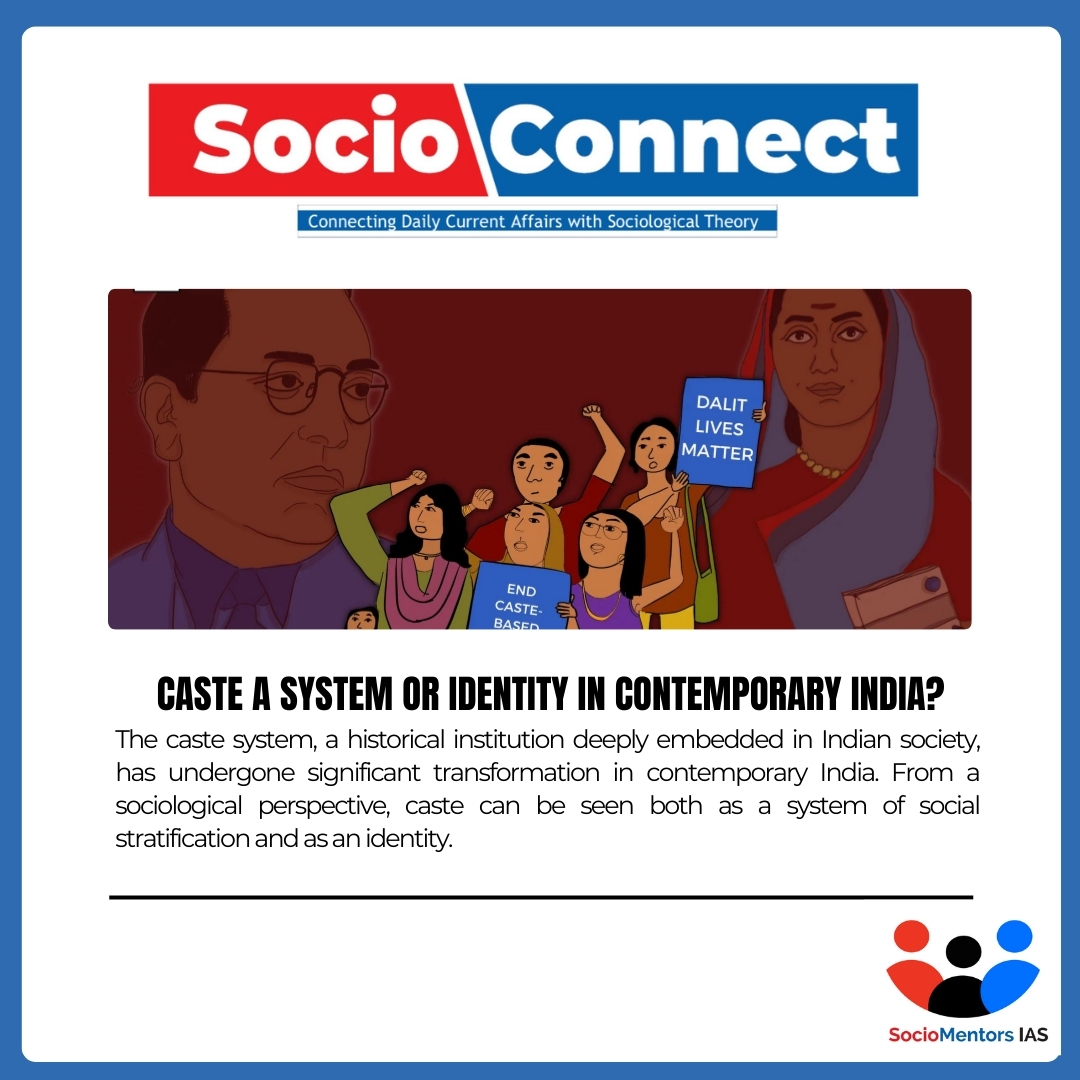Caste a System or Identity in Contemporary India? – UPSC Sociological Perspective
September 9, 2024
Caste system refers to a closed system of stratification in which an individual’s position is fixed at birth. It is one of the most pervasive social institution present in the Indian social structure. The forces of modernisation has brought changes in caste system in India. The constitutional and legislative protections have theoretically ended the discriminative features of caste like untouchability.
In general G.S Ghurye and Louis Dumont have said that caste is a system defined by hierarchy and the notion of purity and pollution. For a caste to exist as a system Ghurye identified a set of features like segmental division of Indian society, occupational division of labour, endogamy, hierarchy, civil and religious disabilities and restrictions on commensality and social intercourse.
HOW CASTE AS A SYSTEM HAS WEAKENED
Many of the features of caste system like hierarchy, social disabilities, occupational division of labour etc. has weakened after independence.
- With urbanisation and modern means of communication and transport ritual purity of castes have faded from urban areas. People intermix freely on formal and informal places without caste restrictions. S. Ghurye also highlighted how urbanization has led to the anonymity of individuals, where one’s caste identity becomes less visible in the urban workforce. Caste-based occupations have declined, and professional networks now transcend caste boundaries.
- Hierarchy of the caste system has changed. In legal terms no caste can declare itself to be superior to another. There is also a change in position of castes and it is no long based on the norms of ritual purity. Even in rural areas where caste system was strong, ascendant castes like Jats, Kurumis etc have taken the place of dominant castes. The loss of traditional relations in agriculture has also led to disintegration of caste hierarchy.
- Untouchability has weakened and there is greater awareness even among the upper caste not to practice untouchability. Superiority is no longer defined by ritual purity. Capitalization, modernization and liberalisation has helped castes in the lower sections to climb up the ladder.
- Occupational division of castes also does not exist in strict forms in the country. Andre Béteille emphasized the decline of caste-based occupations in modern economic settings. He argued that while caste once determined one’s profession, modern education and capitalist economies provide new pathways for social mobility that are independent of caste identity. The rise of the middle class and white-collar jobs further contribute to a weakening of caste’s role in determining one’s livelihood.
- Endogamy in castes have decreased especially in urban areas. According to Vivek Kumar, there is less resistance to inter- caste marriages and there is more self-choice marriage among all the castes.
- Politicization of Caste: Anil Bhatti describes the weakening of the traditional caste system due to democratic elections, which opened up new spaces for Dalits and OBCs to hold political office and influence decision-making processes. This shift from caste hierarchy to caste politics has introduced significant social change.
HOW CASTE STILL EXISTS AS AN IDENTITY?
Andre Beteille is of the opinion that caste has transformed into identity and consciousness. Identity as a concept has the notion that the group or the person is conscious of his own self and regards his importance. Every caste now is trying to assert its identity.
- Caste in Politics: Badri Narayan who studied UP elections said caste identity has become important. A pattern in which people prefer and vote for candidates who belong to their own caste has been observed in the country.
- Caste Associations: Srinivas says caste has accommodated with democracy and many of the dominant castes in different parts of the country have become parts of the political parties. Caste based trade unions and organizations were developed by leaders like Kanshi Ram. This organizations became so powerful that they act as pressure groups to influence the government. Caste based informal groups exists even within professional associations to further interests of their own caste members.
- Caste based reservation in education and jobs gave a major thrust to caste identities and caste based organisations. Many numerically strong castes like Jats, Marathas now demand reservation and are politically backed.
- Endogamy: Matrimonial advertisements often specify caste, reflecting its enduring importance in family decisions. Even though legally inter- caste marriages are permitted, caste is a major determinant in spouse selection. This is evident from the fact that only 5.8% of Indian marriages were inter-caste, according to Census 2011, a rate unchanged over 40 years.
- Caste Abuse: Harassment of people using casteist slurs and various forms of verbal and non-verbal violence exhibited against lower caste people indicates that a mentality of caste-based discrimination and inter caste hostility still exists even in urban areas.
- Caste in private life: The study of rickshawallas of Lucknow by Harold Gould also shows that caste still exists in private life and caste identities are strong among all sections though it appears diffused in public life.
- Social media and digital platforms have given rise to new ways of expressing caste identity. Online communities form around caste groups, allowing for both the assertion of identity and the discussion of caste issues.
Thus, as noted by M N Srinivas in his essay ‘An obituary of caste system’, caste system no longer exists but castes do exist. Caste has adapted with the modernizing forces and is losing features of a system but is acquiring characteristics of identity in the form of casteism.



